5 Essential Tools for Starting Your At-Home Yoga Practice
This post contains affiliate links. What does that mean? If you make a purchase using a link marked as an affiliate link, I may receive a small commission.
Whether we’re social distancing or back to our pre-pandemic routine, incorporating a private, at-home yoga practice is a great way to practice self-care and compassion, and is also a great way to enhance your regular yoga practice.
You don’t need to go out and buy a ton of expensive yoga props if you’re just getting started, but there are some pretty basic items that I think everyone should have on hand for their at-home yoga practice.
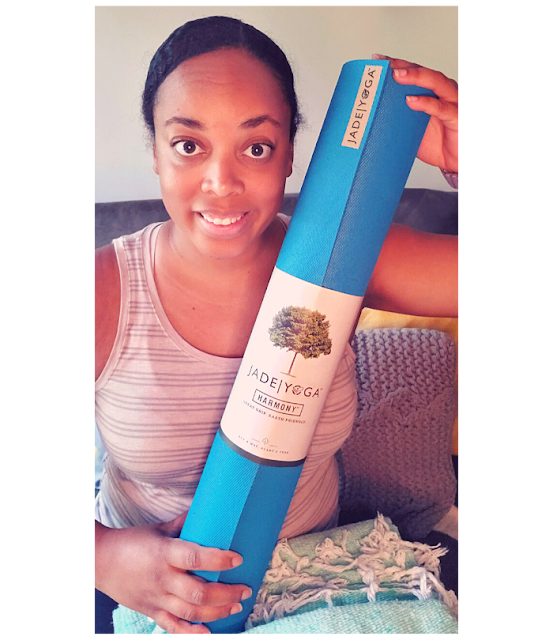
Yoga Mat
Do I Really Need It?
Some people might argue that you don’t need a yoga mat to practice yoga, and I would generally agree; however, I find that using a yoga mat helps with avoiding slipping, maintaining alignment in certain poses, providing some cushioning, and avoiding getting dirty from the surface below your mat (which can be a major distraction, taking you out of your practice).
What To Look For
- First, you want to make sure that you pick a yoga mat and not a workout mat. I know this seems obvious, but you’d be surprised how often people make this mistake! They roll up similarly, so if you’re shopping in a store (especially places like TJ Maxx where they’re in the same area), you may pick up the wrong item. Be sure that it says yoga mat!
- The length of the yoga mat will depend on your height. In general, you want a yoga mat that is 68 inches long. If you are tall, you may want to pick up an extra-long mat. As for the thickness, you generally want to pick one that is 3-5mm in thickness. My Jade Yoga Harmony Mat (affiliate link) is 5mm in thickness, so it’s a little bit thicker than most of the mats I’ve previously owned, but it’s the perfect thickness for me! Please note that travel mats tend to run thinner so that they are lighter weight and easier to pack. Be mindful of this while you’re on the hunt for a mat.
- Does your yoga mat come with a strap? For some folks, this is a must-have. Some brands sell the straps or yoga bags separately, while some come with a strap or bag.
- Think about how often you’re planning to practice, and consider a higher-quality mat if you’re going to be practicing pretty regularly (at least twice a week). Investing in a high-quality mat can result in a major payoff. For example, I purchased my newest mat for about $60 more than I’d ever spent on a yoga mat; however, my friend who recommended it has had hers for 10 years and hers remains in excellent condition, and she uses it very frequently. I consider this mat an investment, and I hope I won’t have to buy another one for a very long time!
- One thing to note: Are you practicing indoors or outdoors? If you are practicing outdoors, make sure you check the care instructions on your mat to see if it is advised for outdoor use. If not, here’s a tip: Grab a mat with at least average cushion and that you don’t mind getting dirty and maybe a little scraped up. I use one of my cheap TJ Maxx mats for this purpose (they’re usually a solid brand like Gaiam, but they only run about $10 and you can get a lot of use out of them!).
What Do I Do With My Old Yoga Mats? Can I Recycle Them?
Light reading: Here’s an article from Yoga Journal on the history of yoga mats.
Yoga Blocks
Do I Really Need Them?
What To Look For
- I like to use cork yoga blocks when I practice in studios, but I purchased my yoga blocks before I knew about these (d’oh!). Cork blocks can be a little bit heavier and feel a bit sturdier; however, my foam yoga blocks work just fine!
- I have a thicker set and a leaner set, but I seldom use my thicker set of yoga blocks. If you lack flexibility and are brand new, I would recommend purchasing both a leaner set and a thicker set; otherwise, you may just want to pick up a leaner set. They tend to be easier to grip and can slide easily under your hips in poses like pigeon pose.
- Think about the material of your yoga blocks – you don’t want them to be slippery because this could lead to injury if your hands are sweaty or the surface is too slick.
Blanket
Do I Really Need It?
What To Look For
- Color: If the color matters to you, you may be frustrated when shopping online. Some online sellers give you a range of colors that they offer, and they will put in small writing that you may receive whichever color they give you. Make sure you keep your eyes open for this! You should also note that since many are handwoven, there may be some color variation.
- Material: You do not want a raggedy, jaggedy, crusty, dusty old blanket. Peep the material when you are shopping, or you could end up as one salty yogi during your practice!
- Size: Does size matter? That’s the eternal question, isn’t it? My newest yoga blanket (affiliate link) is a little bigger as I mentioned, but my smaller blanket (affiliate link) is still a great size. I use them interchangeably, or I use them together if my practice calls for it, or just if I want to sit on the floor.
- Cost: You do not need to pay an arm and a leg for a good yoga blanket. You can typically buy a good yoga blanket for about $10-25.
- Care Instructions: You want to make sure that your yoga blanket lasts, so check the care instructions before purchasing. Sometimes this will help you make your decision before purchasing it.
Space
Do I Really Need It?
What To Look For
A Quiet, Dedicated Area
Do I Really Need It?
What To Look For
The ideal location is one that does not have a lot of foot traffic in your home, perhaps is an enclosed space to keep out the lurkers and interrupters (but this is not necessary), and is a good temperature for you. If you’re near an air or heat vent, you may want to close it during your yoga practice as this can become uncomfortable and distracting.
Notice a theme? Try to avoid distractions (that are within your control) during your yoga practice!
Anything Else?
- Bolster: My mom and I made mine, but you can buy a bolter online or in stores. If you don’t want to buy a yoga bolster, you can sometimes use extra blankets, pillows, or even sofa cushions. Pro tip: TJ Maxx often sells yoga bolsters for a lot cheaper than online stores if you can find them.
- Yoga Mat Strap: As I noted before, not every yoga mat comes with a strap. If yours does not, and you plan to take your yoga mat to a studio or anywhere else, you may wish to consider purchasing a strap.
- Yoga Mat Bag: If you don’t want a strap, or maybe you want a little extra protection for your mat, a yoga mat bag is another great way to protect your yoga mat.
- Yoga Strap: This is different from a yoga mat strap, as this is usually one straight piece that resembles a belt. I don’t use a yoga strap in most of my yoga practices (I typically use mine for stretching), but they are great to have on hand for some practices and for gentle stretching. Some even double as a yoga mat strap! If you don’t want to buy a yoga strap, you can use a scarf or even a belt (though, I should note that it should be more of a fabric belt than a leather/vegan leather belt).
- Wireless headphones: If you have issues finding a quiet space, wireless headphones can be a great solution! I like to listen to music or listen to a class while I practice yoga. Unfortunately, I don’t always have a quiet space. This allows me to escape from the noise around me; however, with my Aftershokz headphones, I can still hear my surroundings in case someone knocks at my door or there are some other sounds.
Heads Up!
Looking for more yoga tips? Starting this Tuesday, I am hosting Yoga Teacher Talk Tuesday! Check it out to learn from yoga teachers on a variety of topics.
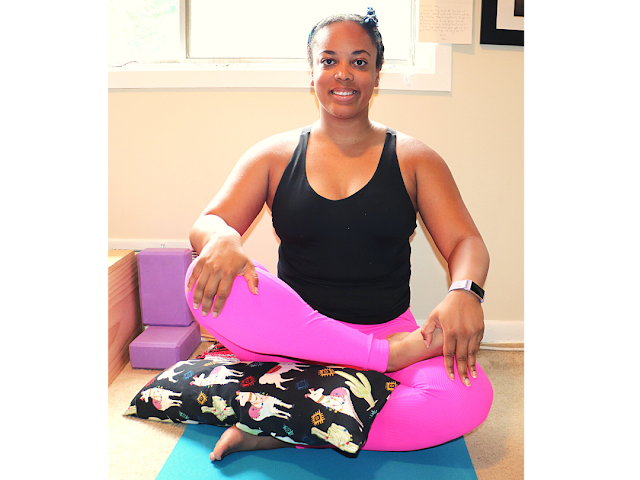
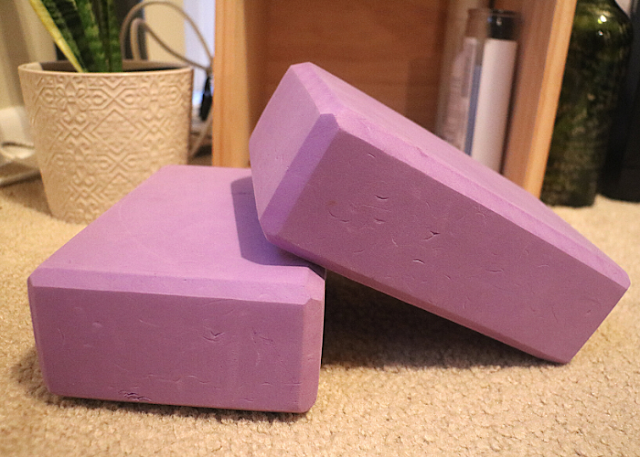
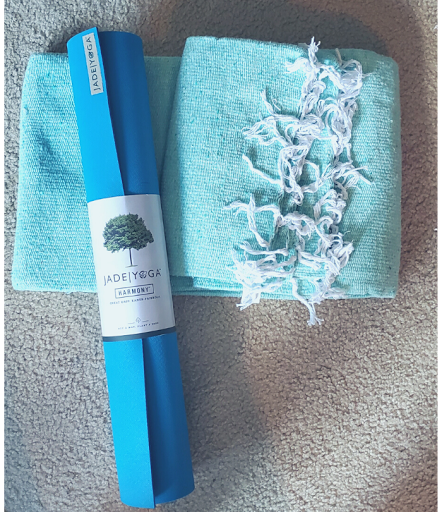

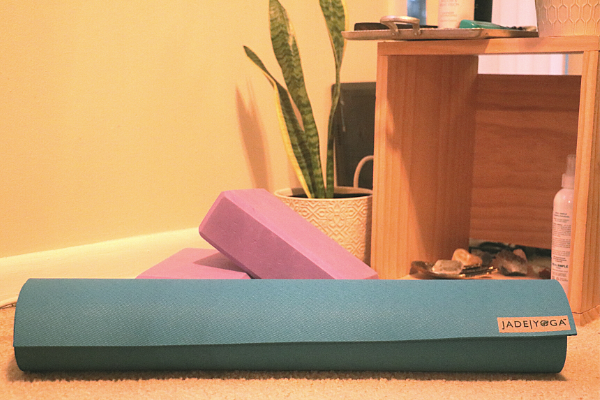
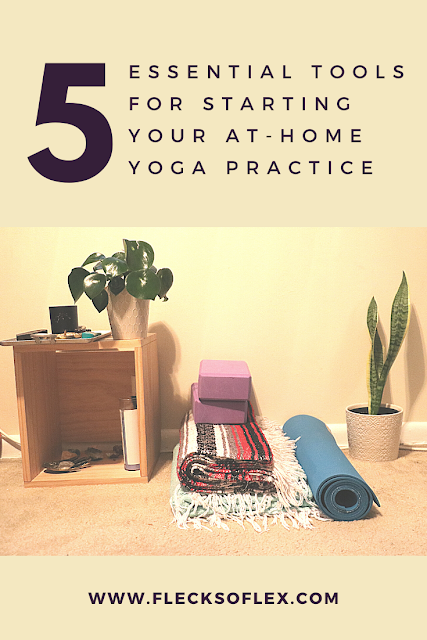
I never thought about recycling an old yoga mat-what a great idea. I also like having the blanket just in case I need a little extra support. Great tips
Fabulous tips! I have a mat for indoors and outdoors. That one goes to the beach. I have a strap but no other props.
Fabulous tips! I have a mat for indoors and outdoors. That one goes to the beach. I have a strap but no other props.
Oh I love this! I have been doing yoga at home for many years. I'm so glad I have all the basic you've mentioned!
Oh I love this! I have been doing yoga at home for many years. I'm so glad I have all the basic you've mentioned!
These are some wonderful tips! I had no clue that you could recycle yoga mats! That's so helpful!
These are some wonderful tips! I had no clue that you could recycle yoga mats! That's so helpful!
Such great tips! I have a dedicated gym space that I use and love. It makes all of the difference.
I am just getting in to doing yoga at home. So, this post was super helpful, love the tips!!!
I am just getting in to doing yoga at home. So, this post was super helpful, love the tips!!!